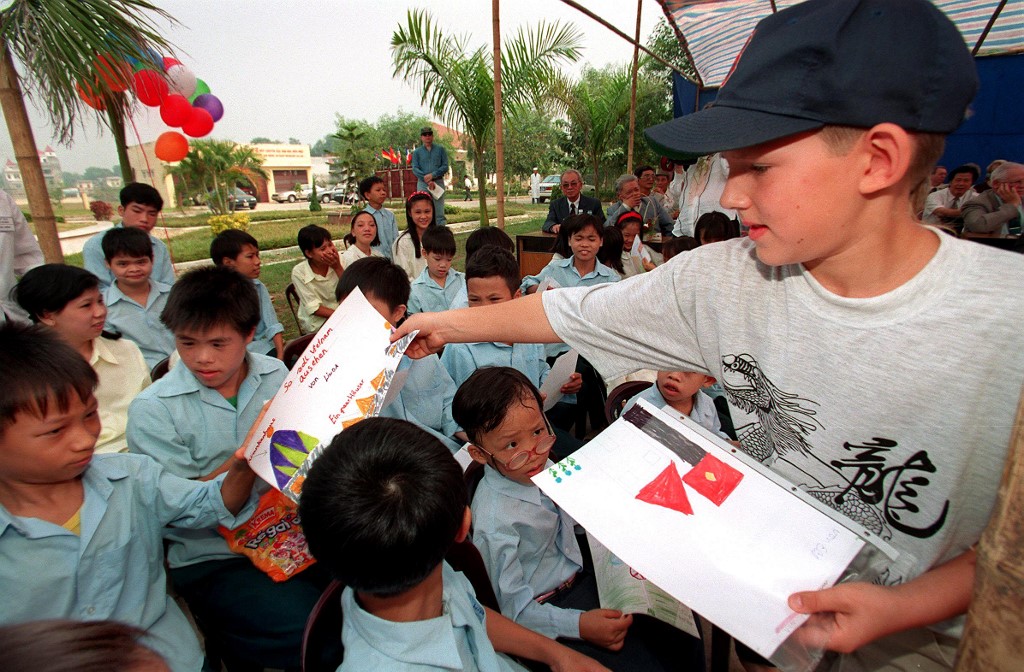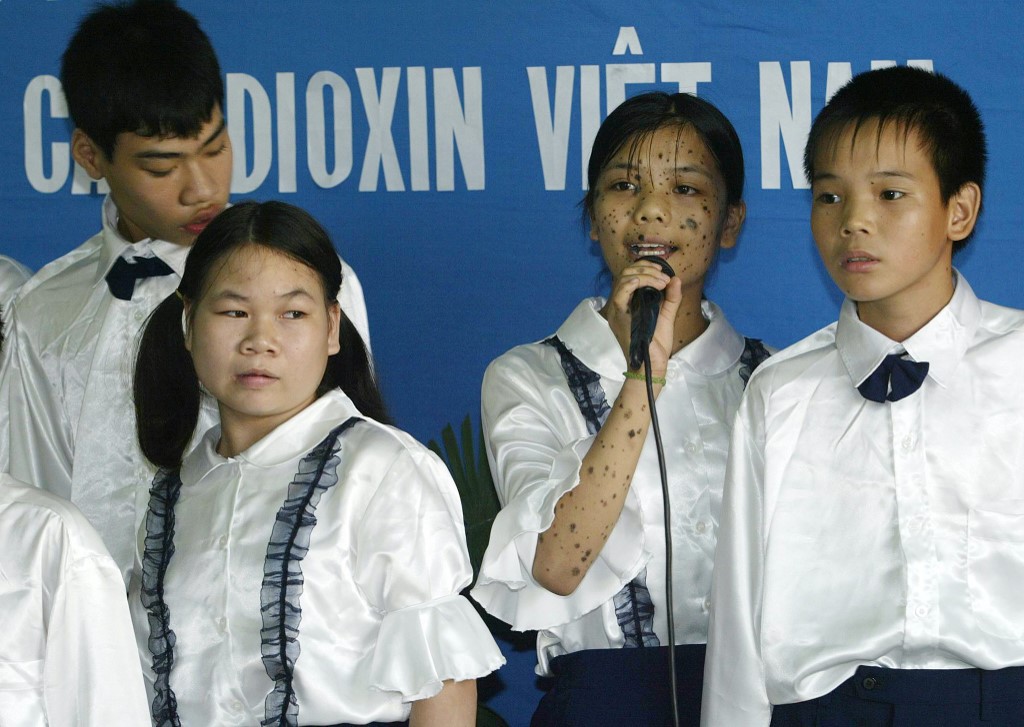It’s November 1988 in Ho Chi Minh City, and John Schuchardt and George Mizo are having dinner with a member of Vietnam’s Interior Ministry, a senior monk, and Mr Hai, their translator.
Rain is beating at the windows and Schuchardt can hear the distant clatter of passing bicycles and children playing in the streets outside. The visiting Americans, a pair of veterans from the Vietnam-American War, explained to the monk over a table of citrus heavy seafood and a bed of watercress, that they wanted to build a peace pagoda.
While the monk appreciated the gesture, in post-war Vietnam, they needed something more tangible.
“You are the first messengers to bring harmony,” the monk said. “We appreciate it, but we haven’t recovered materially or spiritually. Peace Pagoda would be meaningful, but we urgently need schools and hospitals.”
At that time, Vietnam was only two years into the Doi Moi economic reforms, which created a socialist-oriented market economy, resulting in rapid economic growth in the decades after. The war just over a decade prior had taken a heavy toll on Vietnam, with around 2 million Vietnamese civilians killed and another 5.3 million injured.
But the longest-lasting effects were mostly unseeable, and passed down through generations. Agent Orange – a herbicide sprayed liberally across Vietnam, Cambodia and Laos to defoliate thick forests that concealed guerillas – first used 59 years ago on 18 January, 1962 as part of “Operation Ranch Hand”. In the decade that followed, more than 20 million gallons of toxic chemicals were sprayed, and by the war’s end, more than 4 million Vietnamese citizens had been exposed to poisonous chemicals.
Today, traces of the chemicals remain in the fish, birds, animals, land and water in Vietnam, and have been linked to birth defects through generations of Vietnamese citizens. Lawsuits against US manufacturers, mainly Dow Chemical and Monsanto, continue to this day, though often to little success, and the latest trial between French-Vietnamese journalist Tran To Nga, herself a victim, and the companies that manufactured Agent Orange is set to take place on 25 January.
While it took until 2006 for the US government to accept responsibility for multi-generational health impacts, veterans like Mizo had long-known the true harms of the chemical, experiencing its effects firsthand. When he returned to Vietnam for his meeting with the monk, he was still recovering from open-heart surgery he’d undergone just weeks earlier, which had been linked to his exposure to Agent Orange. He would die in 2002 of complications related to the herbicides.

But back on that November day in 1988, while speaking over dinner, Mizo accepted that his impulse to build another pagoda in a land that needed so much was misguided. It was that night that the veteran decided instead that he would build a clinic for child victims of Agent Orange.
Some 10 years after that first meeting, the doors of Friendship Village were opened.
A complex of archetypal communist-inspired Vietnamese buildings in Ha Tay, about 15 km southwest of central Hanoi, Friendship Village is equipped with medical centres, classrooms and room and board that supplied medical care, physical therapy, education and vocational training to citizens suffering from the long term effects from Agent Orange.
Today, despite the decades passing, the school still educates children born with birth defects as a result of the chemical. Over the usual ruckus of class in progress, Nguyen Thu Huen, a teacher at the school for 16 years, said students generally stay at the centre for five to seven years, and can range in ages from children to adults.
She said it’s not unheard of for pupils from exceptional circumstances to stay longer if they don’t have a family to go back to, or their family is too impoverished to take care of them.
If you have a chance to visit here then you can see that the children here have many problems. Mental health and physical health

“This is so much better than the environment that they have come from. They have someone to take care of them, who teaches them for free,” she said. “The children here, especially the kids who attend vocational studies, have more chances of getting a job than the kids who study a formal curriculum. If you have a chance to visit here then you can see that the children here have many problems. Mental health and physical health.”
Friendship Village is just one of roughly 10 similar projects throughout Vietnam. At any given time, the centre will care for approximately 150 people born with disabilities linked to Agent Orange exposure. Most have parents who fought in the war, and continued to live in areas that were dusted with the toxic chemical.
The herbicide contained a chemical, dioxin, linked to cancers, neurological disorders, spina bifida, immunodeficiency, disorders in the endocrine system, reproduction disorders and birth defects throughout communities in Vietnam where the chemical was sprayed. It is thought that the chemical enters the genes, passing its harmful legacy from one generation to the next. Nobody knows exactly how many generations will be affected.
Each year, the organisers of Friendship Village travel to provinces that were hit worst by Agent Orange, such as Hoang Binh in central Vietnam, and visit Viet Cong veterans. They travel down muddy paths where the cars can’t reach to find their homes. These are often the country’s poorest, with 70% of the families classified as living below the poverty line according to the Vietnamese Association for Victims of Agent Orange. Many dioxin victims are seriously disabled, and 90% are unemployed.
“Each year we go to the provinces affected by Agent Orange to visit veterans. We meet their children and try to understand their needs,” said Nguyen. “If they have children, or relatives who have been impacted by Agent Orange, they invite them to attend our school. Usually, living here is so much better than where they used to live.”
But even as holding chemical producers directly accountable for these lasting effects has failed, there has been a slow but lasting shift in care for people affected by Agent Orange in Vietnam.
In years prior, the chronic illnesses and birth defects caused by dioxin poisoning were largely dealt with by families, or in privately run, donor-funded facilities like Friendship Village. However, amidst a growing warmth between the US and Vietnam in the decades after the end of war, the long aftermath of Operation Ranch Hand has become a more open topic of discussion with a stronger role for public aid.
Consequently, help is moving from private, donor-funded centres to US aid-backed projects, as the US government gradually acknowledges the legacy of dioxin left behind after the war. Between 2007 and 2021, the US Congress directed nearly $390 million towards remedying the environmental and health damages of dioxin.

Charles Bailey, is the director of the Agent Orange in Vietnam programme of the Aspen Institute, an international nonprofit organisation, and the co-author of From Enemies to Partners: Vietnam, the U.S. and Agent Orange – a book tracing the history and role of dioxin poisoning within a budding diplomatic relationship.
Bailey told the Globe that, for a long time after the normalisation of diplomatic ties in 1995, the legacy of Agent Orange was not a subject the two countries could discuss without risking fallout.
“Agent Orange is a highly fraught subject. You have to begin talking about it by breaking it down into small chunks,” said Bailey. “It turned out that the point of entry was through the environmental consequences, particularly where dioxin might be – what environmentalists call the fate of the contaminant. Until that question was answered, it was impossible to talk about its impacts on people today.”
From 1997-2007, Bailey worked with the global non-governmental organisation Ford Foundation as its representative in Vietnam. Bailey researched Agent Orange and began to develop the vocabulary that US and Vietnamese officials could use to discuss the issue. He said it was that reframing, centring the environmental impact, that resulted in the clean up of ‘hot spots’ such as Danang Airport.
While the environmental impact has proved a gateway for government-to-government aid directed towards the health effects of Agent Orange, Bailey said the dioxin issue is one that requires work and knowledge at the local level through organisations like Friendship Village.
“I think the first rule of doing this kind of work is empathy,” he said. “You can only have empathy if you can go and talk to people, and then go and visit them and show respect and try to understand.”
He added that, while you can’t change the past, it is important for organisations to focus on improving the future for those impacted by Agent Orange.
“You can’t restore the souls that have been lost and the damage that has been done, but you can certainly create conditions where it doesn’t continue,” he said. “That means cleaning up the dioxin and the majority of people who are likely affected living lives of greater dignity and comfort.”


